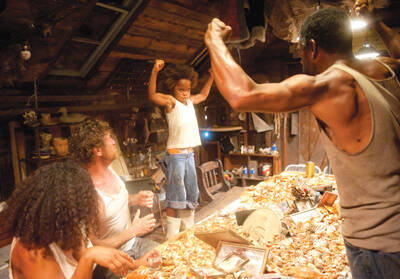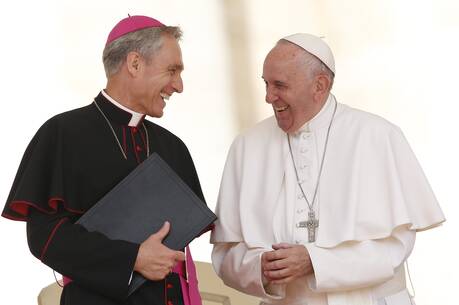Until now, the most powerful depictions of Hurricane Katrina’s impact on New Orleans and the gulf region I have seen are Spike Lee’s documentary “When the Levees Broke” and the HBO series “Treme.” The first treats the immediate consequences of the 2005 storm; the latter considers its lingering psychological effects.
The extraordinary new movie Beasts of the Southern Wild does both, without ever mentioning Katrina or the Crescent City. It is the feature-length debut of director Benh Zeitlin, who, together with Lucy Alibar, adapted Alibar’s stage play “Juicy and Delicious.” Among its offerings are poetic language, transfixing visuals, a mythic narrative and two vivid characters.
Hushpuppy, the 6-year-old heroine, and her ailing father, Wink, reside on the edge of habitable terra firma in a fictional South Louisiana community called the Bathtub—a place where ribbons of soggy earth melt into the Gulf of Mexico. While spinning a tale of survival, “Beasts” finds buried links between morality and a threatened ecosystem. Calling to mind works as disparate as “King Lear,” “Precious” and Terence Malick’s “The Tree of Life,” “Beasts” suggests that our place in the fantasia of existence is both more and less primitive than we tend to assume.
Heady stuff, yet “Beasts” is as tactile as it is spiritual. Indeed, Zeitlin and company seem bent on spanning such dualities as earth and water, human and animal, bounty and deprivation, black and white, realism and fantasy, self-reliance and interdependence, liberal and conservative. And instead of coming off as an anthropological study, political tract or proscriptive exercise, it is an entertaining fable that rises to the level of art.
This would not be possible without astonishing performances by two first-time actors. As Hushpuppy, Quvenzhané Wallis, age 5 when cast, is startlingly poised. You won’t soon forget watching this spiky-haired waif trudging through the muck or devouring crabs in her white rubber boots, sleeveless t-shirt and orange underpants. And Dwight Henry, a baker from New Orleans, is terrific playing her gruff dad.
In voice-over, Hushpuppy comments on their circumstances, articulating many of the film’s themes. She and Wink live in a kind of idyllic squalor, each in a separate ramshackle dwelling amid a menagerie of dogs, chickens and other wild and semi-domesticated fauna. They travel the waterways in a boat fashioned out of an old Chevy pickup, and he teaches her to fish with her hands (“It’s my job to keep you from dying!”). They grill chickens at “feed-up time” and feast on vats of shimmering crawfish with their Bathtub neighbors. Like most every adult, Wink is always swigging alcohol, which can’t be good for his heart condition.
The hierarchy within this egalitarian, interspecies community is dictated by the food chain—the strong eat the weak. But the alchemy of survival also depends on another basic principle articulated by Miss Bathsheba, who tells the children: “The most important thing I can teach you—you gotta learn to take care of people smaller and sweeter than you are.”
When Wink goes missing, however, Hushpuppy is left to fend for herself. Her mother’s whereabouts are unknown, although Hushpuppy associates her with a light that flickers out over the water, on a buoy perhaps. Before we learn more about that light, Wink returns and a big storm approaches.
Father and daughter make preparations and check in with the Bathtub’s other denizens. After the floodwaters recede, several of the men target a levee with explosives, and the authorities evacuate everyone to a government shelter, where Wink’s health deteriorates. Hushpuppy, with a few kids in tow, goes in search of her mother.
The disaster, more severe in degree than kind, ruptures the community but is met with fortitude. This tenacity is accompanied by an appreciation for—and desire to create—beauty and meaning. Food is celebrated with authentic locavore relish; and Hushpuppy draws pictures to help make sense of things. Her fears are represented by a set of menacing Paleolithic creatures resembling giant, tusked boars. Throughout the movie, Zeitlin splices in brief fantasy sequences featuring these beasts.
Everything builds toward a eucharistic moment involving another predatory (and prehistoric) creature, plus the region’s culinary tradition. In his sickbed, Wink is fed deep-fried alligator, sustenance embodying the dual wisdom that keeps everyone in the Bathtub afloat. Helping fellow creatures in need follows from the realization that all things are connected. Enjoying the fruits and navigating the hazards of one’s natural surroundings entails recognizing the necessity of balance and harmony.
This may make the movie sound like a Sierra Club infomercial, particularly in light of Katrina, the Deepwater Horizon oil spill (which happened just days before “Beasts” began filming) or any other of the environmental catastrophes that seem to occur more frequently these days. Yet “Beasts of the Southern Wild” transcends climate-change debates and never tastes like a dose of celluloid medicine dispensed by some indie green machine. Its formal integrity allows it to span tired, easily politicized dichotomies as it offers a timeless, universal message.
Hushpuppy has digested its holistic wisdom. Seeing evacuees receive medical care in the shelter clinic, she notes, “When an animal gets sick, they plug it into the wall.” She is not criticizing modern medicine’s mechanical approach to healing, despite the mistrust Wink and other Bathtub residents have for our technology-driven civilization. She is expressing wonderment at this unfamiliar means of restoring equilibrium between body and soul.
Talking with a ferry captain while searching for her mother, she declares, “I want to be cohesive,” acknowledging the need for a unity and harmony that is simultaneously practical, aesthetic and spiritual. And before feeding Wink the alligator, she courageously dismisses her demons by saying, “I gotta take care of mine.”
Acknowledging her place in the larger scheme of things, recognizing the stubborn material and metaphysical truth about the interconnectedness of all things, Hushpuppy believes her highest calling is to care for others, starting with those closest to her—since it is “we who the earth is for.”









I thought this film was mostly about relationships - the dependence we have on one another when push comes to shove, and how we try to live up to our responsibilities in whatever flawed ways we know. I think the word is "solidarity." The Dad barbecuing chicken for the girl, the people in the store sticking together, the girl bringing back the food to her Dad, even the ladies of the night on the floating bordello dancing with the girls. Nobody really had the tools to do anything very effective but they responded on some deep level to each other's need. Does that happen in reality? I'd like to think so, but maybe that's just me.